Hydraulics and pneumatics
In this chapter, you will revise what you know about moving objects with air and water. You will learn more about the differences between pneumatic and hydraulic systems, and you will learn how to use hydraulic systems to make a small force move a heavy object.
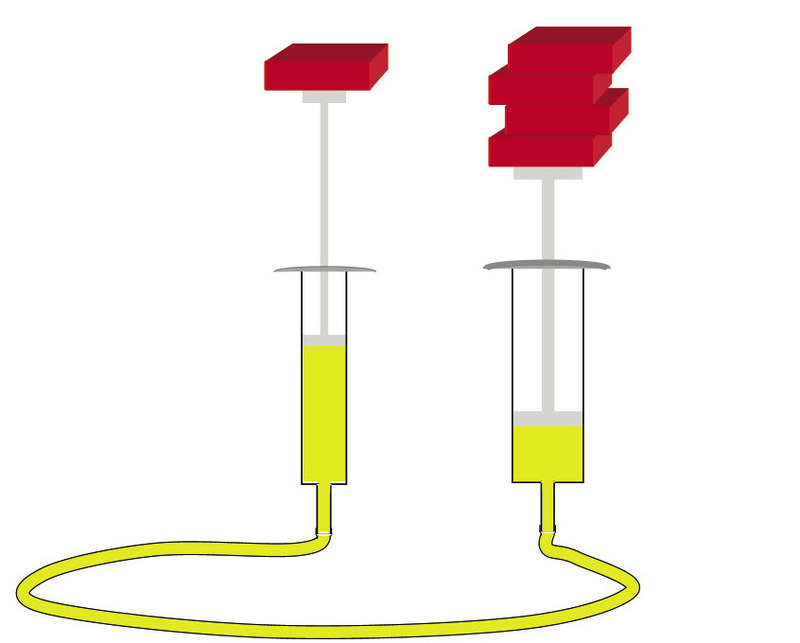
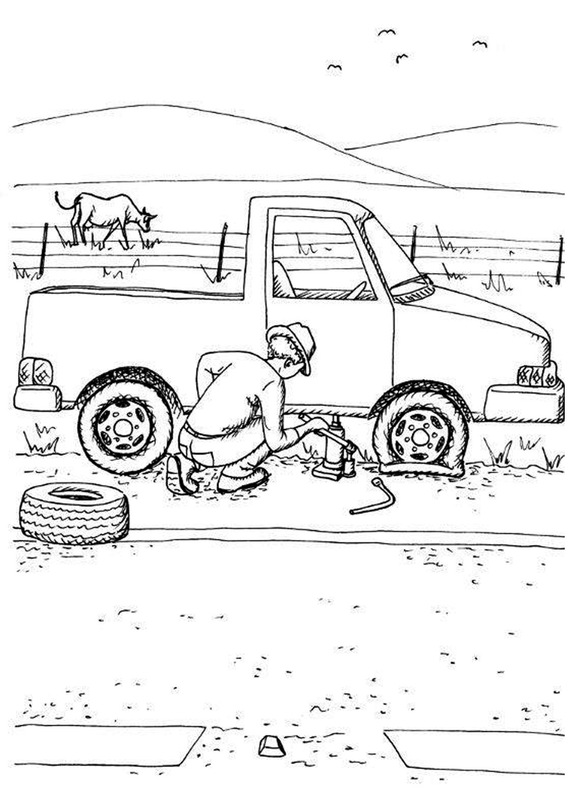
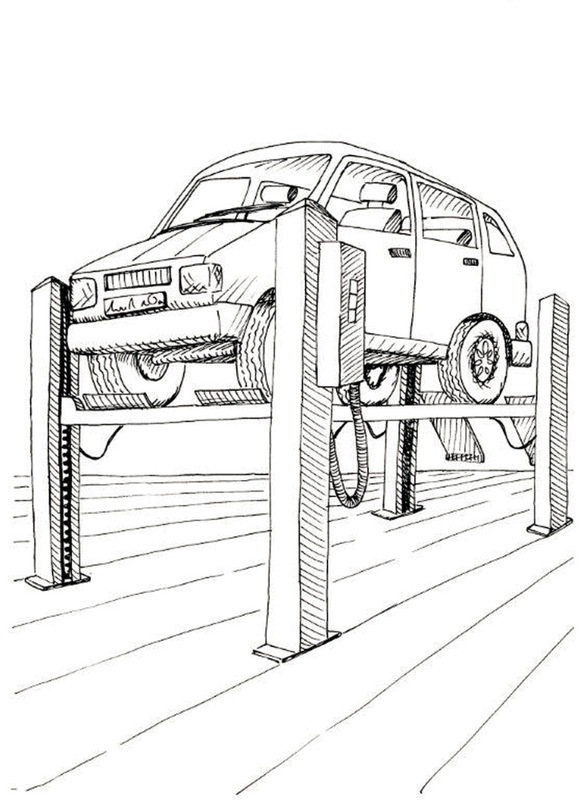
Use water and air to move objects
Compressible and incompressible substances
The blue tin contains bundled straw, the red tin contains water and the yellow tin contains sand.
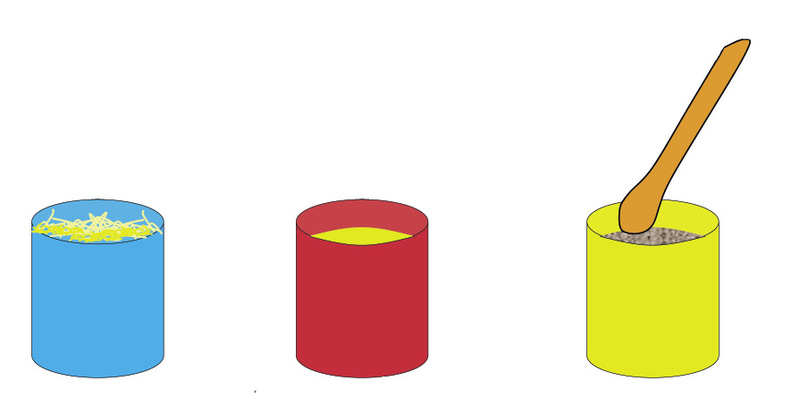
-
Do you think it is possible to compress the sand with the wooden spoon so that it takes less space in the yellow tin? Yes/No
-
Do you think it is possible to compress the straw? Yes/No
-
Do you think it is possible to compress the water? Yes/No
Straw, grass and paper bundles are compressible. This means that it can be compressed to take up less space. Sand is incompressible. That means it cannot be compressed to take up less space.
-
-
Is water compressible or incompressible?
-
Is air compressible or incompressible?
-
How can one use a syringe to investigate the compressibility of air and water?
-
Air is compressible, but water is incompressible.
Two syringes that are connected with a tube can be called a syringe system.
If the tube and syringes are filled with air, it is called a pneumatic system.
If it is filled with water or oil, it is called a hydraulic system.
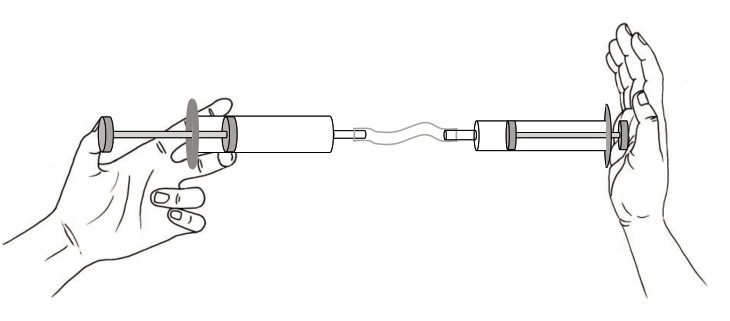
-
When the plunger on the left is pressed in, the plunger on the right presses against the hand. Will the pressure on the hand be the same with a pneumatic system as with a hydraulic system? Explain your answer.
A pneumatic and a hydraulic system are shown below. In each case the two syringes are exactly the same size. Two heavy objects of the same weight are resting on plungers on the right.
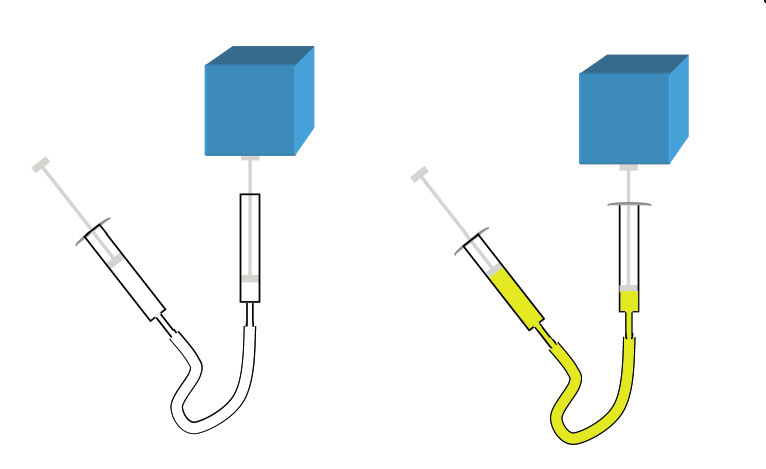
Figure 6 -
If the plunger on the left is pressed in by 2 cm in both systems, what will happen to the blue objects? Explain your answer.
Narrow and wide syringes
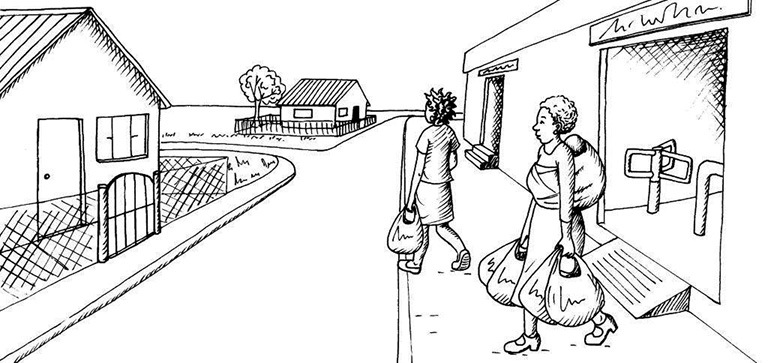
-
The woman carrying the big load only has to walk a short distance to her home. The woman with the small load has to walk quite far to her home. Who will be the most tired when she gets home? Explain your answer.
The picture below shows a two-syringe system with a smaller and a bigger syringe. The system was filled with water until there were no air bubbles.
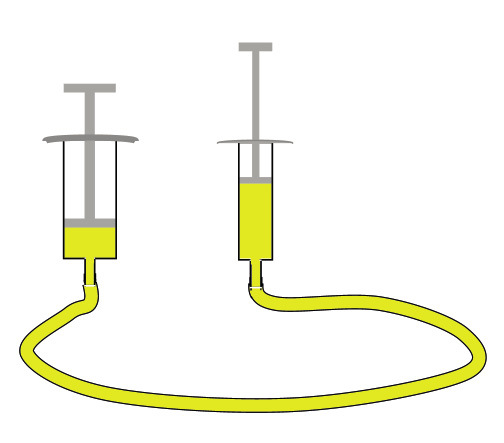
Action research
You will now do more action research with two syringes. To do that, you need to make an apparatus.
Copy these rulers onto a drawing and attach them to a sheet of corrugated cardboard or a cereal box. The lines are 2 mm apart.
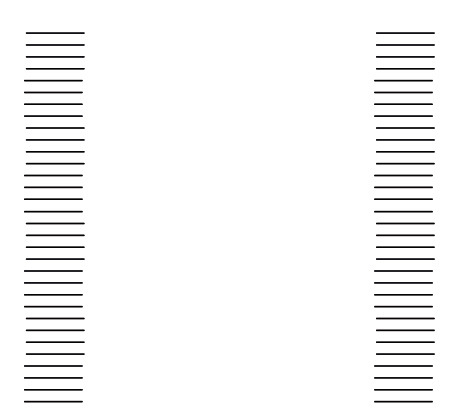
Attach your two-syringe system with tape to the cardboard sheet or box, as shown on the next page.
If you press the plunger on the left in, the plunger on the right will move out.
The syringe on which you push the plunger in is called the input or master cylinder of the system. The syringe that is moved is called the output or slave cylinder of the system.
Instead of "master cylinder", you can say driver cylinder.
You will now do research to find out how far the output cylinder moves out when the input cylinder is pushed in for a certain distance.
-
Draw water into the input cylinder so that is almost full, and the plunger is right next to one of the marks on the ruler.
-
Make a small mark at the top of the plunger of the output cylinder.
-
Push the input cylinder plunger 1 cm in.
-
Measure how far the output cylinder plunger has moved.
-
Enter your measurement in the table below.
-
Repeat steps 1 to 4, but now push the input cylinder 2 cm in.
-
Repeat all the steps from 1 to 4 for distances of 3 cm and 4 cm.
|
Input cylinder movement in cm |
1 |
2 |
3 |
4 |
|
Output cylinder movement in cm |
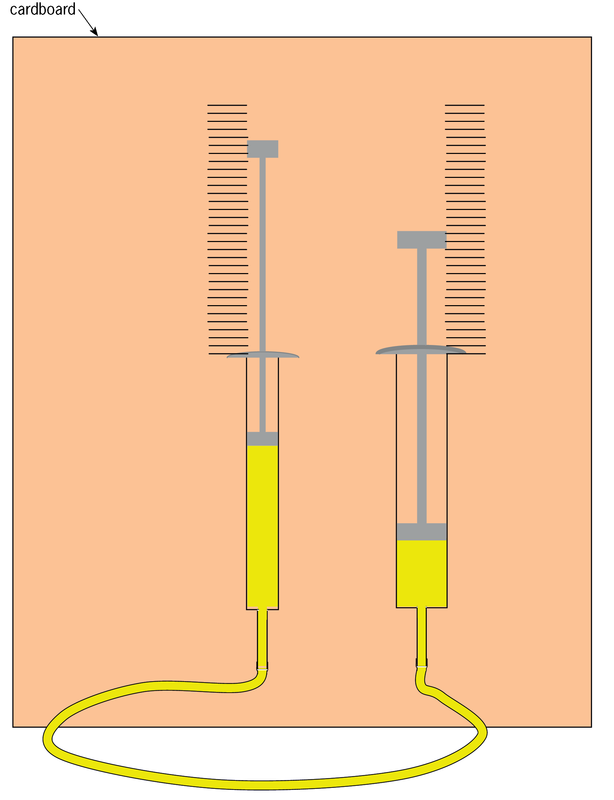
-
Now think of the scenario where you made the wide syringe the master cylinder, and the narrow syringe the slave cylinder. How far do you think the plunger of the narrow syringe will move when you press the plunger of the wide syringe 1 cm in?
-
Also predict what will happen if you press the plunger of the wide cylinder ½ cm, 1 cm or 2 cm in. Write your predictions on the table below.
Wide master cylinder movement in cm
½
1
2
Narrow slave cylinder movement in cm
-
If you still have time, do more research to check your predictions.
Wide master cylinder movement in cm
½
1
2
Narrow slave cylinder movement in cm
You do work when you press in the master cylinder. And the slave cylinder does work when it moves on the other side. The amount of work ”put in“ on the input side (master cylinder) must be the same as the amount of work that ”comes out“ on the output side (slave cylinder).
-
What do you notice? You have now investigated how the distance of movement changes when you transfer work from one syringe to another syringe with a different width. Is it only the distance of movement that change when you transfer work from one cylinder to a different cylinder?
Put a finger on the plunger of the slave cylinder when you press the plunger of the master cylinder. Do this in two ways, by using the narrow cylinder as the master cylinder, and by using the wide cylinder as the master cylinder.
Change the size of forces using a hydraulic system
The picture shows a plastic bag filled with water. If you put your left index finger gently against the bag and then pressed against the bag with your right index finger, what do you think you would feel with your left index finger?
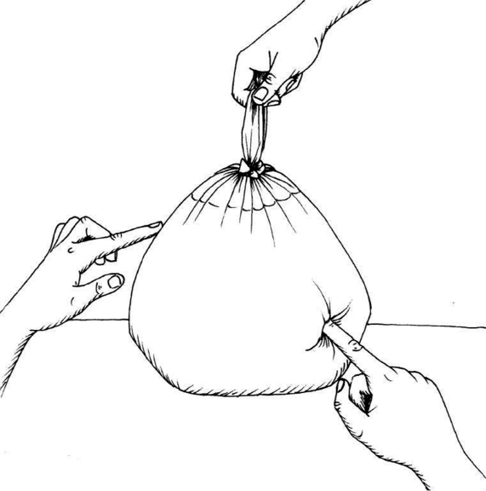
When pressure is applied to a flexible container with liquid, the same pressure is felt everywhere in the container. The pressure is "transmitted" or "transferred" through the liquid.
Note: "Pressure" is not the same as "force", although it is related to it. A man called Blaise Pascal realised this a few centuries ago and wrote about it. It is called Pascal's principle.
You will now do action research to investigate how pressure is transmitted through water. To do this, you need the same syringe system on a cardboard base that you used in the previous section. This time, put it upright and support it with books, or something else that is sturdy. You also need a few objects that are equal in weight, like small boxes filled with sand.
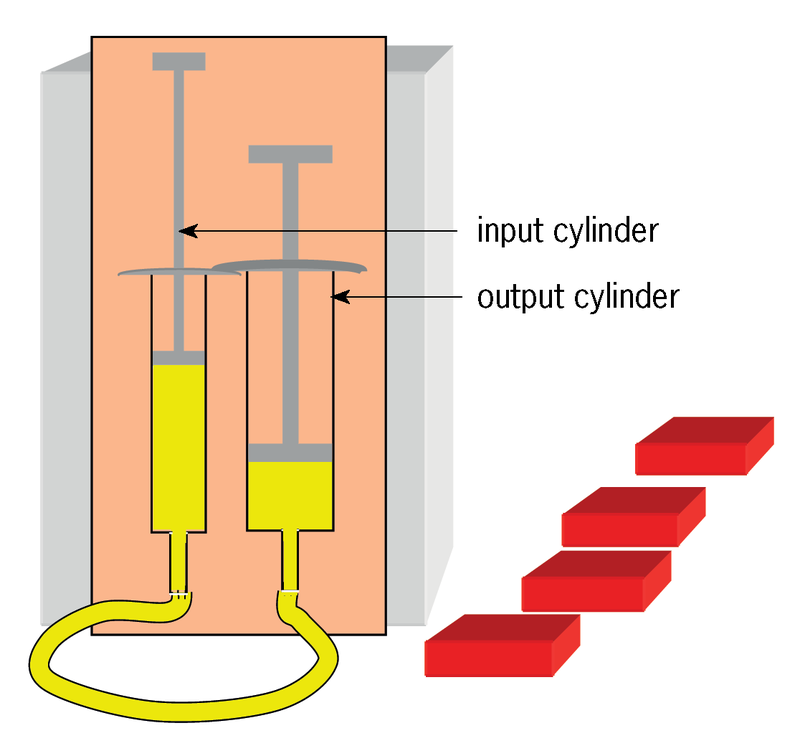
-
Draw water into the wider cylinder until it is almost full. You will use this as the input cylinder.
-
Put one box on the plunger of the output cylinder. Put another box on the plunger of the input cylinder.
-
Does the plunger on the output cylinder move?
-
Put another box on the plunger of the input cylinder. If the plunger on the output cylinder still does not move, put more boxes on the input cylinder.
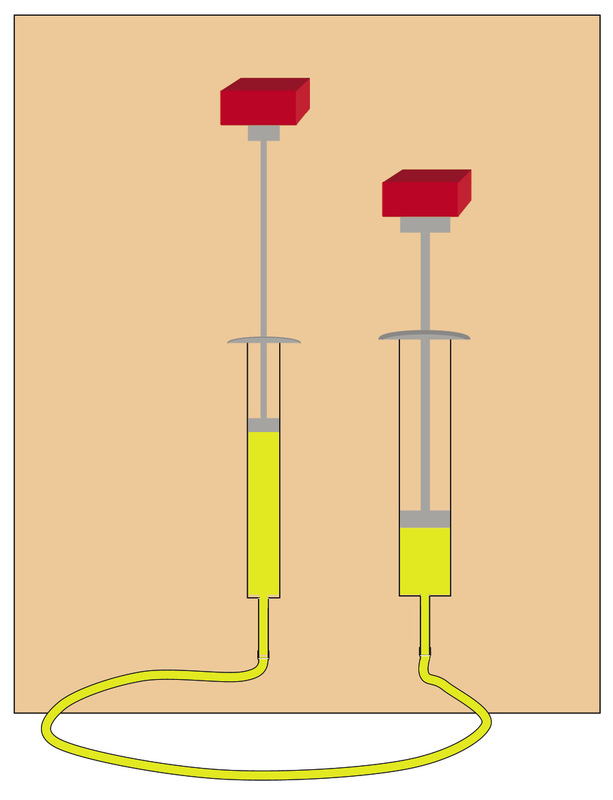
Figure 10 -
Think about what you have just observed. How do the boxes you have placed on the master cylinder affect the slave cylinder?
The boxes on the master cylinder press downwards on the plunger in the system. This force is transmitted through the water to the plunger on the slave cylinder, and it pushes the plunger of the slave cylinder upwards.
Instead of saying "the boxes press downwards", technologists usually say "the boxes exert a downward force".
-
Did the plunger on the slave cylinder move the same distance as the plunger on the master cylinder?
-
Was the force exerted by the boxes you placed on the master cylinder equal to the upwards force exerted on the one box on top of the slave cylinder?
-
Think back to the two women who walked carrying bags to their homes, in the story at the beginning of section 5.2. What does their story and this experiment have in common? Think carefully before you write your answer in the space below.
When work is transferred from a wide cylinder to a narrow cylinder, the force exerted by the narrow cylinder is smaller than the force that is applied to the wide cylinder. That is why you had to put more than one box on the wide cylinder before it could move the one box on the narrow cylinder upwards. The pressure of the liquid is the same everywhere, on the input cylinder as well as the output cylinder. But because the input cylinder is wider, the force on the input cylinder is greater than the force on the output cylinder.
Next week
In the next chapter, you will learn how hydraulic systems are used to lift cars and other heavy objects.



